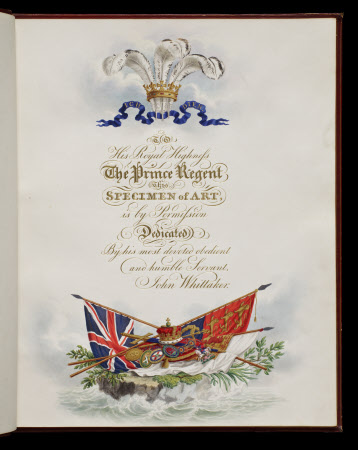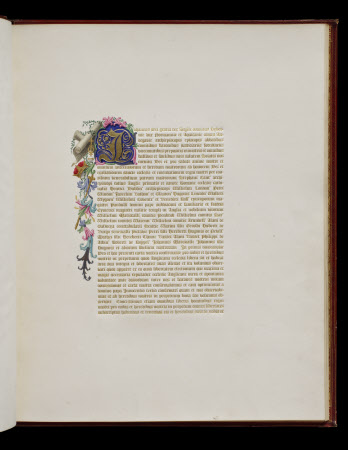Magna Carta Regis Johannis : XV. Die Junii, MCCXV. Anno Regni XVII. A.D. MCCXV.
John Whittaker (d.1831)
Category
Books
Date
1816
Materials
Leather, paper, card, gold leaf and pigment
Measurements
436 x 360 x 21 mm
Place of origin
London
Order this imageCollection
Anglesey Abbey, Cambridgeshire
NT 3101504
Summary
WHITTAKER, John (publisher) -- Magna Carta Regis Johannis XV. Die Junii MCCXV. Anno regni XVII. A.D. MCCXV. London: John Whittaker, 1816. Bound by Hering 9, Newman Street. Printed on letters of gold on card, printed on one side only. Hand-painted and illuminated in colour and gold; Bound in long grained red morocco, richly tooled in gilt and blind, roll tooled borders of oak leaves and acorns , centre ornament on each cover within a wreath of roses, shamrocks, thistles, oak leaves and acorns , tooled and panelled back, gilt inside borders , green watered-silk linings to boards with gilt borders. Book mark of green silk.
Full description
This remarkable and rather extraordinary book was published to mark the 600th anniversary of the original issue of Magna Cana in 1215. Printed in burnished gold letters by a secret process invented by the bookbinder John Whittaker, copies were priced, according to Lowndes, from 10 to 250 guineas, depending on the level of decoration and the lavishness of the binding. It was said to be the first book printed in gold and, unsurprisingly, no two copies arc exactly alike. Despite the offer of a prize by the Society for the Encouragement of the Arts, Whittaker kept his method of gold printing a secret. It was divulged only after his death, when it was revealed to the Jury of the Great Exhibition of 1851 by John Harris Jr (1791-1873), whose father, the miniaturist John Harris Sr (1767-1832), had carried out much of the decorative painting in Magna Carta under the supervision of the Prince Regent's heraldic artist, Thomas Willement (1786-1871): ‘The page is composed in moveable type in the usual way; a stereotype-plate is taken. A piece of iron of the size of the page, about half-an-inch in thickness, is made hot, and placed on the table of an ordinary typographical printing-press; the stereotype-plate is then placed on the iron plate, and gets hot, and leaf-gold of an extra thickness, of the size of the plate, is laid very carefully on the surface of the plate; then the paper or vellum is placed on the tympan in the usual way, having previously been sifted over with dried glaze of egg and rosin finely pulverised, which adheres to it in sufficient quantity; the tympan is then turned down, and the pull dwelt on. The degree of heat must be ascertained by practice; if the plate be too hot, the plate is dead and drossy; if too cold, then it appears bright but imperfect.’ Many of the Fairhaven books at Anglesey Abbey must have had a personal or sentimental interest for their owner, and this extraordinary tour de force is no exception. Following the death of Fairhaven's father, Urban Hanlon Broughton, his widow Cara, Lady Fairhaven and their two sons presented Runnymede to the National Trust, commissioning a memorial from Sir Edwin Lutyens (1869-1944), who designed a sober array of kiosks and piers, one inscribed: ‘In these Meads on 15th June 1215 King John at the instance of Deputies from the whole community of the Realm granted the Great Charter the earliest of constitutional documents whereunder ancient and cherished customs were confirmed abuses redressed and the administration of justice facilitated new provisions formulated for the preservation of peace and every individual perpetually secured in the free enjoyment of his life and property.’ and the other: ‘In perpetual memory of Urban Hanlon Broughton 1857-1929 of Park Close Englefield Green in the county of Surrey Sometime Member of Parliament These meadows of historic interest on 18th December 1929 were gladly offered to the Nation by his widow Cara Lady Fairhaven and his sons Huttleston Lord Fairhaven and Henry Broughton.’ Text adapted from Mark Purcell's entry in ‘Treasures from Lord Fairhaven’s Library at Anglesey Abbey’, National Trust, 2013, cat. 28, pp.98-9.
Bibliographic description
[15] leaves : col. ill., coats of arms ; fol. Hand-painted and illuminated in colour and gold; printed in gold. Loosely inserted: Typed sheet on headed paper of bookseller Charles J. Sawyer, describing this copy. Price clipped out. Provenance: 1. Nineteenth-century armorial bookplate: Earl of Leitrim (not in Franks; possible variant of Franks 6051: arms of Clements with Bermingham on an escutcheon [i.e. Nathaniel Clements, 2nd Earl of Leitrim (1768-1854), married Mary, daughter and coheir of William Bermingham of Boss Hill, co. Galway]. 2. Ms. inscription: John Burns. August 16th 1927 (M). Binding: Nineteenth-century full red morocco over boards; elaborately tooled in gilt and blind, roll-tools and fillets to form a border, with motif of oak leaves and acorns; gilt central panel and centrepiece, with wreath of leaves and flowers; gilt-panelled spine; spine gilt, with title ‘Magna Carta’’ gilt inner border; green watered silk endpapers; binder’s ticket: Bound by Hering, 9, Newman Street.
Provenance
Purchased at an unknown date from Charles J. Sawyer, London, presumably by Huttleston Rogers Broughton, 1st Lord Fairhaven (1896-1966) and then bequeathed by him to the National Trust with the house and the rest of the contents in 1966.
Makers and roles
John Whittaker (d.1831), publisher John Harris the younger (1791-1873), printer
Exhibition history
Magna Carta Exhibition, Chertsey Museum, Chertsey, 2015
References
Mark Purcell, William Hale and David Person, Treasures from Lord Fairhaven’s Library at Anglesey Abbey, Swindon: National Trust; London: Scala Arts & Heritage Publishers, 2013., pp. 98-9


